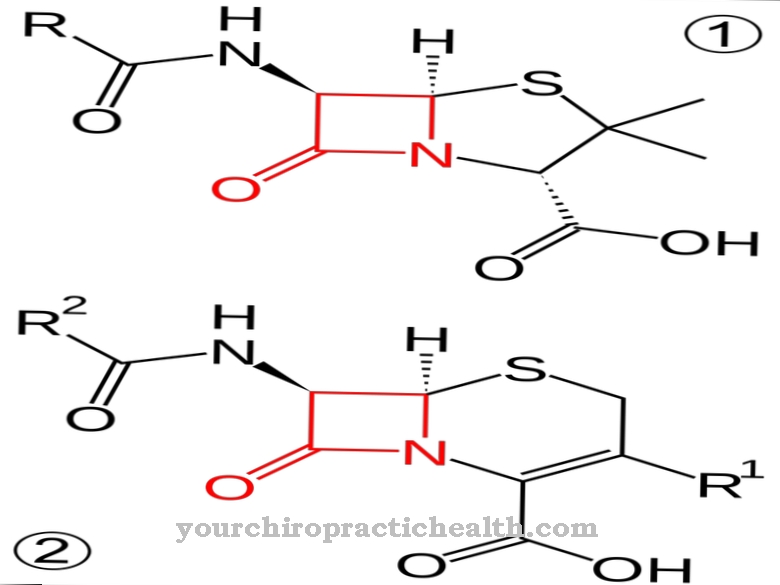At Sulbactam is a beta-lactamase inhibitor. The active ingredient extends the spectrum of activity of beta-lactam antibiotics (also ß-lactam antibiotics), but has only a weak antibacterial effect.
What is Sulbactam?
As a medicinal substance, sulbactam belongs to the group of ß-lactamase inhibitors and is a synthetic penicillic acid sulfone. It is used in combination with ß-lactam antibiotics, the effect of which it expands. The chemical structure is the same, but the bacterial effect is only weak. By using sulbactam in conjunction with ß-lactam antibiotics, the therapeutic safety is significantly higher than would be the case with monotherapy alone.
In Germany, the drug is sold under the trade names Combactam® (monopreparation) as well as Ampicillin / Sulbactam, Ampicillin comp and Unacid® (combination preparations).
Pharmacological effect on the body and organs
Sulbactam inhibits many forms of the ß-lactamases produced by bacteria. The ß-lactamase "ampC Cephalosporinase", which is produced by Enterobacter, Citrobacter, Pseudomonas aeruginosa and Serratia, among others, is not inhibited. Sulbactam binds irreversibly to the enzyme ß-lactamase, which prevents the enzyme from functioning. This prevents the antibiotic from being inactivated so that the antibiotic effect can be developed on the bacterium.
Sulbactam can hardly be absorbed in the digestive tract. For this reason, it is usually administered parenterally via a short infusion. Immediately after the end of an infusion lasting 15 minutes, the maximum serum concentration of sulbactam is reached.
The bioavailability of an injection into the muscle is also 99 percent, the absorption takes place almost completely and reliably about 30 to 60 minutes after administration of the drug. Sulbactam is well distributed in tissue and body fluids. The distribution is only limited in the liquor, but the effect is increased if there is an inflammation there.
Among the ß-lactamase inhibitors, sulbactam has the greatest affinity; the formation of plasma proteins is 38 percent. The approximate plasma half-life of sulbactam is one hour.
Sulbactam is primarily excreted through tubular secretion (active excretion of substances such as urea and acid as well as ammonia in the primary urine) and glomerular filtration (ultrafiltration of the blood in the kidney corpuscles, material separation of blood and primary urine). Sulbactam is not metabolized, which is why it is excreted primarily via the kidneys.
Medical application & use for treatment & prevention
Sulbactam supports the action of antibiotics. It is neither bactericidal nor bacteriostatic itself. Rather, it inhibits the enzyme ß-lactamase, which is formed by some bacteria and is able to split the ß-lactam ring in antibiotics (e.g. penicillin, cephalosporin). The antibiotic becomes ineffective by breaking its chemical structure. The antibiotic regains its effectiveness through the administration of sulbactam.
The administration of sulbactam takes place parenterally before the antibiotic. This in turn should have a similar half-life. The level of the dose depends on the sensitivity of the pathogen and is usually between 0.5 and 1.0 grams of sulbactam. The maximum daily dose is four grams. The dose must be adjusted accordingly in patients with impaired kidney function.
A prescription of sulbactam is not indicated if there is hypersensitivity to ß-lactam antibiotics. Sulbactam should also not be used in children under one year of age, as the effects at this age have not yet been fully understood.
The administration of sulbactam without the simultaneous administration of a ß-lactam antibiotic does not make sense because it does not have its own effect. Embryotoxic and teratogenic effects could not be proven in animal experiments. However, there is insufficient experience with use in humans. It has been clarified that the medicinal substance passes into breast milk, although no damage has yet been found in infants. During pregnancy and breastfeeding, sulbactam should therefore only be administered after careful determination of the indication and after weighing the benefit and risk.
Risks & side effects
As with any medication, undesirable side effects can also occur with the administration of sulbactam. Side effects include allergic reactions (e.g. skin rash, increased eosinophil count, anaphylactic shock), digestive tract disorders, local injection site reactions, interstitial nephritis (inflammatory disease of the kidneys) and an increase in liver values due to the combination with the antibiotic. In addition, the side effects of the antibiotic can be aggravated.
With simultaneous use of drugs such as aminoglycosides and metronidazole, precipitation, clouding and discoloration occur. These interactions are also to be expected with parenterally applicable tetracycline derivatives (e.g. doxycycline, oxytetracycline and rolitetracycline), with noradrenaline, sodium pentothal, prednisolone and suxamethonium chloride, which is why the individual drugs must be administered separately from one another.




























.jpg)